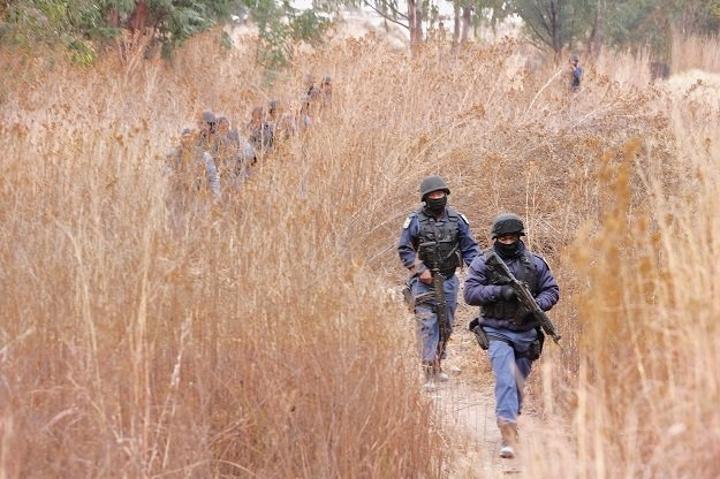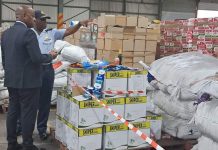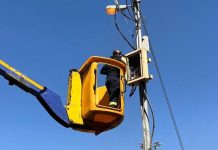Africa-Press – South-Africa. The challenge of addressing illegal mining is complex and cannot be achieved with “takedown” operations and dramatic shows of force, no matter how often they occur, writes Julian Rademeyer.
It took the gang rape of eight women for the South African Police Service to finally act against illegal miners in Mogale City. And when they did, it was with a “takedown” operation of the kind that has become a stock response to criminal atrocities so terrible they can no longer be ignored.
Dozens of police officers, along with tactical response teams, the police Special Task Force and mining security flooded the area, arresting close to a hundred suspected illegal miners, or zama zamas, as they are more commonly known. It was a show-of-force for the cameras, but one that in isolation will have little long-term benefit for a community strangled by organised crime.
ANALYSIS: Amanda Gouws – Rape is endemic in SA. Why the ANC government keeps missing the mark
The roots of this underworld economy run far deeper than the abandoned mine shafts and tunnels that dot the landscape. It has festered for well over a decade in the void left by a largely absent police service, unable or unwilling to fulfil their constitutional mandate, riven with corruption, lacking any real strategy, capacity, or skills to investigate complex organised crime and terrified of the very criminals they are meant to apprehend.
Adding fuel to the fire
And the zama zamas are at the very bottom rungs of a thriving illicit economy centered on Johannesburg that primarily benefits South African scrap metal and gold dealers, jewellers, gold refineries and exporters.
The horrific rapes and subsequent arrests of the illegal miners, many of them undocumented migrants from Lesotho, Mozambique and other neighbouring states, added fuel to the hatred that growing numbers of South Africans feel towards the “foreigners” they blame for rising violent crime, joblessness and insecurity. Images of tyres, matches and petrol were shared on social media amid calls to #PutSouthAFricansFirst. Some politicians cynically seized on the xenophobic sentiment. Elements in the ANC equated illegal immigrants with rapists in a widely derided march in which they protested their own government failures.
In Kagiso on the West Rand, hundreds of residents took to the streets in search of zama zamas and “foreigners”. Armed with sjamboks, knives, hammers, shovels and rocks, the poor hunted the poor in an explosion of vigilantism, xenophobic violence and murder. Shacks purportedly belonging to zama zamas were set alight. Some suspected illegal miners were beaten, stripped naked and publicly humiliated before being handed over to police. At least one suspected zama zama was bludgeoned and stoned to death, a tyre tossed onto his corpse as a whistling crowd ignored pleas to stop.
These scenes, reminiscent of the bloody xenophobic violence that tore through parts of the country in 2008 and 2015, and the unrest in July last year, which left more than 300 dead, are the product of years of neglect by a political elite safely cosseted in blue light brigades and sheltered from the daily misery that is life for most South Africans. They should chill us all. The simmering rage and frustration that has been supressed for so long in so many communities is erupting all around us.
Promise of ‘rolling action’
Police Minister Bheki Cele has promised “rolling action” in all four provinces affected by illegal mining. In a television interview following some of the arrests, he acknowledged the need for wider investigations. “We need to really find the bosses. These guys [the illegal miners], as you see them, nothing tells you they are gold,” he said, gesturing at some of the dusty, unkempt suspects in torn rags waiting to be taken away by police.
It is difficult not to be cynical about these promises.
Illegal gold mining has been on the rise for more than twenty years in South Africa. Underground illegal miners were first reported in 1999, climbing into abandoned shafts in Welkom. Worsening ore grades, rising costs, bouts of labour and social unrest, and falling investment in new mines have all contributed to a sharp decline in the gold mining sector. Widespread layoffs saw the number of workers in the industry fall from 190,000 in 2008 to just 95,000 in 2019. As several large mining operations have closed shop and gone elsewhere, the abandoned shafts have become magnets for growing numbers of illegal miners.
Zama zamas, kingpins, police and the govt: Why the West Rand is burning
The challenge of addressing illegal mining is complex and cannot be achieved with “takedown” operations and dramatic shows of force, no matter how often they occur. Over the past decade, criminal networks involved in illegal mining have exploited the decline in the state’s law-enforcement capacity and rise in corruption, mainly during the tenure of former President Jacob Zuma, and grown in sophistication and influence.
As these networks have expanded, so have the levels of violence. Heavily armed syndicates war over turf, both at the surface and underground. Some zama zama groups, notably from Lesotho, have begun operating as specialised protection rackets, robbing gold from other illegal miners or working as gunmen for syndicates. Weapons seized by the police include assault rifles, shotguns, submachine guns and grenades; investigators believe that many of these weapons are stolen or purchased from the Lesotho police and military forces.
Violent crimes – including murder, assault and sexual offences – occur at significantly higher levels in former gold mining settlements than in South African cities, themselves notorious for violence. The murder rate for the Free State Goldfields region, for example, reached 55 cases per 100 000 people – a rate that would place it among the 15 most violent places on earth in 2019.
Push into operational shifts
Efforts to seal off decommissioned shafts have driven a rise in incursions into operational shafts across the country, with an associated increase in corruption. For gold syndicates to gain access to operational shafts, an entire ‘line’ of employees needs to be paid off, from security guards at the surface to banksmen, winding-engine drivers and miners. The cost of bribing a line of six to seven employees has risen in recent years due to abandoned shafts having become more difficult to enter and currently averages between R65 000 and R70 000 per zama zama in the Free State and Gauteng. Zama zamas also pay mineworkers up to R15 000 each for the use of access cards, allowing them to clock in as regular mine employees’ right through the front door,’ as one official said. One leading mining house in Gauteng apprehends around 200 employees per quarter for aiding illegal miners, yet security officials estimate that the true number of compromised employees is at least five times higher.
In the North West province, security officials allege gold mining syndicates have corrupted entire police stations: one police unit was reported to regularly escort food deliveries to a decommissioned shaft controlled by zama zamas, while police from a different station allegedly escorted gunmen into the area, and a third set of cops served as hitmen for a local kingpin, murdering several of his rivals.
Ralph Mathekga: State failure is turning us into a nation of vigilantes
To fill the void left by police, mining companies were forced to establish their own parallel investigative units. “We can’t go to the local police station near the mine with information about syndicate activity because of corruption,” a mining security manager – speaking on condition of anonymity – said.
“The police warned us about this themselves. Instead, we have handed over a lot of information to the Directorate for Priority Crime Investigation, Crime Intelligence, Provincial and National police structures…You can literally see the syndicates getting bigger and bigger and starting to legitimise themselves, laundering money into lodges, taxi businesses, liquor stores and guest houses.
“At one of our mines, we arrested thousands of illegal miners over the last four years – of which more than 70% are illegal migrants. We account for about 85% of the crime statistics at that police station. But not a single detective or police vehicle was assigned to deal with this. We had to gather the evidence, write the police docket, make a copy in case it went missing, and transport the people we arrested to the police station because the police wouldn’t come and fetch them. Then we had to track the dockets and the prosecution.”
Tarnished ‘City of Gold’
Today, Johannesburg is an increasingly tarnished “City of Gold” and a hub for legal and illegal gold dealers. There, as my colleague Marcena Hunter found in researching illicit gold markets in east and southern Africa, locally produced gold and imports from neighbouring countries, especially Zimbabwe, is traded by peddlers of every stripe.
Gold is laundered by second-hand scrap metal dealers and jewellers with licences to buy and sell gold. Second-hand jewellery and registered precious metals dealers are described as playing a greater role in the financing of the illegal activity than the scrap metal dealers. Small refineries are also a vulnerable point in gold supply chains.
ANC cannot outsource its own failings on illegal immigrants and zama zamas – analyst
There are at least 100 small refineries in Gauteng alone, many of them on the West Rand. Industry analysts and police complain that the SA Diamond and Precious Metal Regulator (SADPMR) shies away from its regulatory mandate and operates opaquely, turning a blind eye to clear reputational and criminal risks.
In South Africa, the second-hand sale of gold, such as gold jewellery, is tax exempt. This has seen the dramatic rise in simple and extraordinarily lucrative VAT scams. Illegally produced gold, either mined locally or smuggled in from neighbouring countries, is melted down into grade doré bars (doré is a semi pure alloy of gold and silver) consistent with the purity of jewellery.
Using this method, newly mined product is disguised as recycled gold. Not only does this make tracking the origins of the metal difficult, but gold merchants can also fabricate transactions in order to falsely claim that they have paid the VAT of 15 percent and submit fraudulent requests for tax rebates. Due to a favourable VAT scheme, much of the gold tends to be laundered into formal supply chains in South Africa rather than being smuggled out of the country to international trade hubs.
Gold exported to the UAE, India and China
An investigation by the South African Revenue Service into the second-hand gold industry uncovered a staggering multi-billion-rand tax fraud scheme and a shadowy underworld of Krugerrands, scrap jewellery, illegal mining and fake invoice factories. The scheme was so immense that just two companies claimed R24.4 billion in allegedly fraudulent VAT refunds between 2012 and March 2020, AmaBhungane reported earlier this year.
Once laundered, gold is exported, primarily to the UAE, and to a lesser extent India and China. Though South Africa declared no doré exports between 2007 and 2017, UAE import data shows that more than 34 tonnes arrived from South Africa between 2012 and 2016. This gold was likely exported legally after being processed by small refineries in Gauteng. Front companies are also essential in the export of illegal gold. These are often export companies with connections to refineries in global hubs such as Dubai. It is difficult to identify and prosecute these actors, in part because many of the companies involved are based beyond South Africa’s jurisdiction.
Why Mokonyane’s cynical antics on zama zamas are offensive
There are no easy solutions to the illegal mining crisis. The fact that it has reached the levels that it has is testimony to the inability of current police strategy to confront and disrupt organised crime.
The need for swift and strategic action is imperative. Organised crime is an existential threat, inflicting a devastating toll on the political, economic and social fabric of South Africa, from central government to rural municipalities and from the Johannesburg Stock Exchange to the spaza shop.
As we argue in a forthcoming Strategic Organised Crime Risk Assessment for South Africa due to be published next month, the prospect of tackling organised crime is daunting but not insurmountable and a well-led and resourced law enforcement strategy could pay quick dividends.
That would require that short-term tactics, like the “takedowns” seen in Mogale City recently and in response to last month’s mass shootings in taverns, are replaced with long-term strategy and intelligence-driven, targeted investigations intended to disrupt and dismantle criminal networks.
Understanding the harms of organised crime is paramount. Criminal harms extend far beyond the act of crime itself and have an impact that is not measurable in police statistics. And it requires a unified response. Everyone has a stake in combating organised crime. While this is a common refrain in societies fractured by organised crime, in South Africa it is especially pertinent due to the long shadow cast by apartheid, the enduring lack of trust between police and communities, and the pervasiveness of corruption, which has eroded official responses.
As bleak as it may seem from recent events, it is vital that fatalistic thinking does not take root. The current levels of organised crime in South Africa are not an immutable fact and the country has a vast array of crime-fighting tools at its disposal. Given the right reforms, investment, institutional leadership and political will, law enforcement can turn the tide on organised crime. Achieving this will be slow and patient work, but the task must be urgently undertaken. Nothing less than the future of the country at stake.
– Julian Rademeyer is the Director for East and Southern Africa at the
Global Initiative Against Transnational Organized Crime (GI-TOC).
*This article draws on the Global Initiative’s Strategic Organised Crime Risk Assessment for South Africa which is due to be publish
ed in September.
For More News And Analysis About South-Africa Follow Africa-Press






